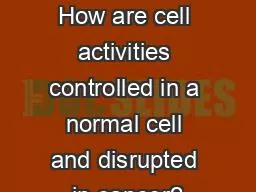

Do Now All the cells in our body have the same DNA yet you have Muscle Cells Neurons Lung Epithelial Cells How is this possible Cells specialize like we do Baby Law Student Art School Student ID: 792056
Download The PPT/PDF document "Cancer Lesson 2.4 How are cell activi..." is the property of its rightful owner. Permission is granted to download and print the materials on this web site for personal, non-commercial use only, and to display it on your personal computer provided you do not modify the materials and that you retain all copyright notices contained in the materials. By downloading content from our website, you accept the terms of this agreement.
Slide1
Cancer
Lesson 2.4
How are cell activities controlled in a normal cell and disrupted in cancer?
Slide2Do Now
All the cells in our body have the same DNA, yet you have:
Muscle Cells
NeuronsLung Epithelial Cells
How is this possible?
Slide3Cells specialize like we do!
Baby
Law StudentArt School Student
High School Student
Lawyer
Artist
Slide4Stem Cells are like “Babies”
A stem cell
can……..
Replicate to produce daughter stem cellsSpecialize or differentiate into many cell types
Slide5Once cells specialize, they become ‘terminally differentiated’
More Specialized
Baby
High school studentLaw studentLawyerStem Cell
Epithelial Stem Cell
Columnar Epithelial Stem Cell
Terminally Differentiated Lung Cell
Slide6Specialization is a trade-off for growth
Terminally differentiated means that the cell is completely specialized, and no longer replicates.
More Specialized
Terminally Differentiated Lung Cell
Slide7In most cases, a terminally differentiated ‘lawyer cell’ can’t become an ‘artist cell’
A lawyer might be able to paint, but because he/she is a lawyer…
He/she will paint like a lawyer, not an artist!
Slide8How do
cells
specialize?
Red blood cellMuscle cellPancreatic cellNeuron
Slide9Cells specialize based on the genes they express
Slide10How do cells determine which genes to express?
Transcription factors‘Opening’/ ‘closing’ of DNA
Slide11A quick review of molecular dogma
DNA
(coding for a gene)
RNAProteinTranscription
Translation
Slide12Cells specialize by
producing specific sets of proteins
This is called gene expression
Slide13Transcription factors control
gene expressionGenes
that encode those proteins are turned ON by specific transcription factors (TF)
GeneTranscription and TranslationProtein
T F
Slide14But transcription factors need DNA to be ‘open’ to turn genes ON
Normally DNA is tightly wound around histone proteins.
Transcription factors can’t bind to tightly wound ‘closed’ DNA. Transcription factors can only bind to loosely wound ‘open’ DNA.
Gene
Histone
DNA tightly wound, not expressed
DNA
Chromosome
Slide15This
is called ‘epigenetic regulation’ of gene expression
Gene
Histone
DNA tightly wound
DNA loosely wound
Acetyl group
DNA ‘opening’ is regulated by modifying the histones
Slide16Adding an acetyl group to the histone loosens its grip on DNA.
The DNA unwinds from the histone, revealing genes.Genes can now be expressed.
Gene
Histone
DNA loosely wound
Acetyl group
How does DNA ‘open’ for expression?
DNA tightly wound, not expressed
Slide17‘Closing’ DNA stops gene expression
Adding a methyl group to the histone
or
the DNA tighten their grip on each other.
The DNA winds up tightly, hiding the genes.
Gene can no longer be expressed.
DNA tightly wound
Gene
Histone
Methyl group
Slide18How would ‘closing’ DNA stop our ‘lawyer cell’
from becoming an ‘artist cell’?
Slide19Activity:
What genes are ‘opened’ and ‘closed’ in our cells?
Slide20In healthy cells, most
proto-oncogenes are usually wound onto histones – so they will not be expressed.But cancer cell DNA is often ‘open’ - proto-oncogenes
can be expressed when they shouldn’t be .
DNA tightly wound
Gene
Histone
Methyl group
DNA loosely wound
Acetyl group
Wrap Up: DNA in cancer cells tends to be in the ‘open’ state
Slide21Specialization is normally
a one way trip!
BabyLaw student
LawyerArtistArt StudentHigh School StudentMore specializedDivides less
Less
Specialized
Divides
more
Cancer cells
Normal cells
Slide22Cancer cells behave like stem cells
Cancer cells lose their specialized functions – Genetic changes
- mutated genes are expressed when they shouldn’t be. Epigenetic changes – open DNA means genes can be expressed at the wrong time.So cancer cells behave more like stem cells than specialized cells.
Slide23Homework
Read workbook chapter 2.4 and answer the question.